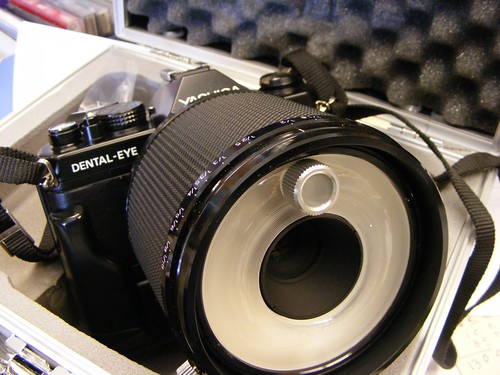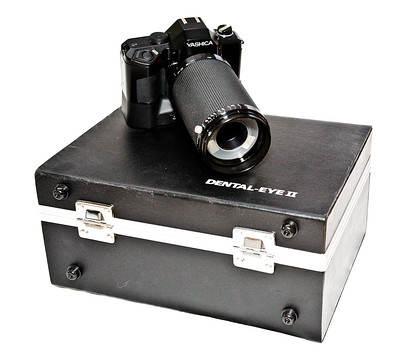Difference between revisions of "Yashica Dental Eye"
(Wayback Machine for inaccessible blog link and better format; add model III image and re-arrange) |
m (some proofreading fixes) |
||
| Line 9: | Line 9: | ||
}} | }} | ||
| − | The '''Dental Eye''' cameras were a series of specialized [[SLR]]s for [[35mm film]] from [[Yashica]], later [[Kyocera]]. These designs replaced the '''Oral-Eye''' series of cameras that | + | The '''Dental Eye''' cameras were a series of specialized [[SLR]]s for [[35mm film]] from [[Yashica]], later [[Kyocera]]. These designs replaced the '''Oral-Eye''' series of cameras that were adapted from the [[Yashica Electro 35|Electro 35]] and distributed by dental equipment company Tokyo Shizaisha. |
| − | The design was optimized for medical and scientific applications, adapting a Yashica SLR body but with a fixed macro lens. The lens barrel included a ring-light flash, around the lens' front element. | + | The design was optimized for medical and scientific applications, adapting a Yashica SLR body but with a fixed macro lens. The lens barrel included a ring-light flash, around the lens's front element. |
None of the Dental Eye models can be focused to infinity. They operate only in the close-focus range, down to 1:1 magnification. | None of the Dental Eye models can be focused to infinity. They operate only in the close-focus range, down to 1:1 magnification. | ||
| − | *Yashica Dental Eye (original), 55mm f/4.0 lens. Based on the [[Yashica FX-3]],<ref>[https://web.archive.org/web/20190703160418/http://www.cvatik.com/log/2018/4/3/camera-oddities-yashica-dental-eye-dental-80s-medical-camera An early Dental Eye still labeled FX-3] is shown on Steven Gindler's blog; archived at the [https://web.archive.org/ Wayback Machine].</ref> | + | *Yashica Dental Eye (original), 55mm f/4.0 lens. Based on the [[Yashica FX-3]],<ref>[https://web.archive.org/web/20190703160418/http://www.cvatik.com/log/2018/4/3/camera-oddities-yashica-dental-eye-dental-80s-medical-camera An early Dental Eye still labeled FX-3] is shown on Steven Gindler's blog; archived at the [https://web.archive.org/ Wayback Machine].</ref> lever film advance. Farthest focus is 1:10 magnification. Aperture is mechanically linked to focus distance. |
*Yashica Dental Eye II, 100mm f/4.0 lens. Motorized advance. Farthest focus now 1:15 magnification. | *Yashica Dental Eye II, 100mm f/4.0 lens. Motorized advance. Farthest focus now 1:15 magnification. | ||
*Yashica Dental Eye III, 100mm f/4.0 lens. Restyled, smaller body. Motorized advance and rewind. Produced from 1997-2006 | *Yashica Dental Eye III, 100mm f/4.0 lens. Restyled, smaller body. Motorized advance and rewind. Produced from 1997-2006 | ||
Revision as of 14:12, 14 December 2022

|
| Yashica Dental Eye (original) image by Mark O'Brien (Image rights) |
The Dental Eye cameras were a series of specialized SLRs for 35mm film from Yashica, later Kyocera. These designs replaced the Oral-Eye series of cameras that were adapted from the Electro 35 and distributed by dental equipment company Tokyo Shizaisha.
The design was optimized for medical and scientific applications, adapting a Yashica SLR body but with a fixed macro lens. The lens barrel included a ring-light flash, around the lens's front element.
None of the Dental Eye models can be focused to infinity. They operate only in the close-focus range, down to 1:1 magnification.
- Yashica Dental Eye (original), 55mm f/4.0 lens. Based on the Yashica FX-3,[1] lever film advance. Farthest focus is 1:10 magnification. Aperture is mechanically linked to focus distance.
- Yashica Dental Eye II, 100mm f/4.0 lens. Motorized advance. Farthest focus now 1:15 magnification.
- Yashica Dental Eye III, 100mm f/4.0 lens. Restyled, smaller body. Motorized advance and rewind. Produced from 1997-2006
Notes
- ↑ An early Dental Eye still labeled FX-3 is shown on Steven Gindler's blog; archived at the Wayback Machine.
Links
- Manual for Dental Eye III from Mike Butkus' OrphanCameras.com
- Dental Eye review from Lomography magazine reviews
|
|
|


